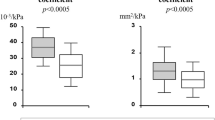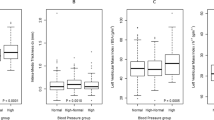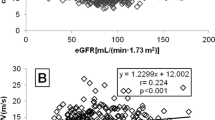Abstract
We evaluated the structural/functional characteristics of the arterial wall in a cohort of hypertensives with well-controlled blood pressure (BP) levels. We studied 40 hypertensives with well-controlled BP. We assessed by B-mode ultrasound the mean intima-media thickness (mean-IMT) and maximum-IMT (M-MAX) of carotid artery (common, bulb, internal) bilaterally. Endothelial function was evaluated by post-occlusion flow-mediated dilation (FMD) of the brachial artery. Along with traditional risk factors, we studied the impact of serum high-sensitivity C-reactive protein (hs-CRP) and osteoprotegerin (OPG). Forty normotensive subjects served as controls. In the hypertensives, the BP levels were well controlled (office BP: 129/79 mm Hg, ambulatory BP monitoring: 121/75 mm Hg). Compared with controls, higher BP levels and body mass index were present in hypertensives, whereas age and metabolic parameters were similar. In hypertensives, the IMT (mean-IMT 0.68 mm, M-MAX 0.81 mm) was significantly higher than in controls (mean-IMT 0.60 mm, M-MAX 0.71 mm). FMD was impaired in hypertensives (5.9%) compared with controls (9.2%). In multivariate analyses, it turned out that in hypertensives IMT parameters were related to age, hs-CRP and OPG. Low-density lipoprotein (LDL) cholesterol was the only factor related to FMD. IMT and FMD had no relationship with BP levels. In conclusion, in hypertensives with well-controlled BP, the pro-atherogenic remodelling (IMT) is mainly dependent on age and the inflammatory cytokines, OPG in particular. The functional impairment of the arterial wall (FMD) was related to the levels of LDL cholesterol. Under these conditions, when the impact of BP is minimized, the role of inflammatory cytokines and lipids on structural/functional remodelling becomes predominant.
This is a preview of subscription content, access via your institution
Access options
Subscribe to this journal
Receive 12 digital issues and online access to articles
$119.00 per year
only $9.92 per issue
Buy this article
- Purchase on Springer Link
- Instant access to full article PDF
Prices may be subject to local taxes which are calculated during checkout

Similar content being viewed by others
References
O'Leary DH, Polak JF, Kronmal RA, Manolio TA, Burke GL, Wolfson SK Jr . Carotid-artery intima and media thickness as a risk factor for myocardial infarction and stroke in older adults. Cardiovascular Health Study Collaborative Research Group. N Engl J Med 1999; 340 (1): 14–22.
Bots ML, Hoes AW, Koudstaal PJ, Hofman A, Grobbee DE . Common carotid intima-media thickness and risk of stroke and myocardial infarction: the Rotterdam Study. Circulation 1997; 96 (5): 1432–1437.
Bots ML, Evans GW, Riley WA, Grobbee DE . Carotid intima-media thickness measurements in intervention studies: design options, progression rates, and sample size considerations: a point of view. Stroke 2003; 34 (12): 2985–2994.
Pauletto P, Palatini P, Da Ros S, Pagliara V, Santipolo N, Baccillieri S et al. Factors underlying the increase in carotid intima-media thickness in borderline hypertensives. Arterioscler Thromb Vasc Biol 1999; 19 (5): 1231–1237.
Lemne C, Jogestrand T, de Faire U . Carotid intima-media thickness and plaque in borderline hypertension. Stroke 1995; 26 (1): 34–39.
Touboul PJ, Hennerici MG, Meairs S, Adams H, Amarenco P, Desvarieux M et al. Mannheim intima-media thickness consensus. Cerebrovasc Dis 2004; 18 (4): 346–349.
Deanfield J, Donald A, Ferri C, Giannattasio C, Halcox J, Halligan S et al. Endothelial function and dysfunction. Part I: Methodological issues for assessment in the different vascular beds: a statement by the Working Group on Endothelin and Endothelial Factors of the European Society of Hypertension. J Hypertens 2005; 23 (1): 7–17.
Yeboah J, Folsom AR, Burke GL, Johnson C, Polak JF, Post W et al. Predictive value of brachial flow-mediated dilation for incident cardiovascular events in a population-based study: the multi-ethnic study of atherosclerosis. Circulation 2009; 120 (6): 502–509.
Taddei S, Virdis A, Ghiadoni L, Sudano I, Salvetti A . Effects of antihypertensive drugs on endothelial dysfunction: clinical implications. Drugs 2002; 62 (2): 265–284.
Ghiadoni L, Faita F, Salvetti M, Cordiano C, Biggi A, Puato M et al. Assessment of flow-mediated dilation reproducibility: a nationwide multicenter study. J Hypertens 2012; 30 (7): 1399–1405.
Ghiadoni L, Magagna A, Versari D, Kardasz I, Huang Y, Taddei S et al. Different effect of antihypertensive drugs on conduit artery endothelial function. Hypertension 2003; 41 (6): 1281–1286.
Hansson GK . Inflammation, atherosclerosis, and coronary artery disease. N Engl J Med 2005; 352 (16): 1685–1695.
Kiechl S, Werner P, Knoflach M, Furtner M, Willeit J, Schett G . The osteoprotegerin/RANK/RANKL system: a bone key to vascular disease. Expert Rev Cardiovasc Ther 2006; 4 (6): 801–811.
Fadini GP, Rattazzi M, Matsumoto T, Asahara T, Khosla S . Emerging role of circulating calcifying cells in the bone-vascular axis. Circulation 2012; 125 (22): 2772–2781.
Puato M, Palatini P, Zanardo M, Dorigatti F, Tirrito C, Rattazzi M et al. Increase in carotid intima-media thickness in grade I hypertensive subjects: white-coat versus sustained hypertension. Hypertension 2008; 51 (5): 1300–1305.
Mancia G, De Backer G, Dominiczak A, Cifkova R, Fagard R, Germano G et al. 2007 ESH-ESC Practice Guidelines for the Management of Arterial Hypertension: ESH-ESC Task Force on the Management of Arterial Hypertension. J Hypertens 2007; 25 (9): 1751–1762.
Palatini P, Graniero GR, Mormino P, Nicolosi L, Mos L, Visentin P et al. Relation between physical training and ambulatory blood pressure in stage I hypertensive subjects. Results of the HARVEST Trial. Hypertension and Ambulatory Recording Venetia Study. Circulation 1994; 90 (6): 2870–2876.
Benetos A, Laurent S, Hoeks AP, Boutouyrie PH, Safar ME . Arterial alterations with aging and high blood pressure. A noninvasive study of carotid and femoral arteries. Arterioscler Thromb 1993; 13 (1): 90–97.
Spence JD, Hegele RA . Noninvasive phenotypes of atherosclerosis. Arterioscler Thromb Vasc Biol 2004; 24 (11): e188 author reply e–9.
Mancini GB, Dahlof B, Diez J . Surrogate markers for cardiovascular disease: structural markers. Circulation 2004; 109 (25 Suppl 1): IV22–IV30.
Den Ruijter HM, Peters SA, Anderson TJ, Britton AR, Dekker JM, Eijkemans MJ et al. Common carotid intima-media thickness measurements in cardiovascular risk prediction: a meta-analysis. JAMA 2012; 308 (8): 796–803.
Versari D, Daghini E, Virdis A, Ghiadoni L, Taddei S . Endothelium-dependent contractions and endothelial dysfunction in human hypertension. Br J Pharmacol 2009; 157 (4): 527–536.
Masoura C, Pitsavos C, Aznaouridis K, Skoumas I, Vlachopoulos C, Stefanadis C . Arterial endothelial function and wall thickness in familial hypercholesterolemia and familial combined hyperlipidemia and the effect of statins. A systematic review and meta-analysis. Atherosclerosis 2011; 214 (1): 129–138.
Vik A, Mathiesen EB, Brox J, Wilsgaard T, Njolstad I, Jorgensen L et al. Relation between serum osteoprotegerin and carotid intima media thickness in a general population - the Tromso Study. J Thromb Haemost 2010; 8 (10): 2133–2139.
Chowienczyk PJ, Watts GF, Cockcroft JR, Ritter JM . Impaired endothelium-dependent vasodilation of forearm resistance vessels in hypercholesterolaemia. Lancet 1992; 340 (8833): 1430–1432.
Griffiths CE, Iaccarino L, Naldi L, Olivieri I, Pipitone N, Salvarani C et al. Psoriasis and psoriatic arthritis: immunological aspects and therapeutic guidelines. Clin Exp Rheumatol 2006; 24 (1 Suppl 40): S72–S78.
Zannettino AC, Holding CA, Diamond P, Atkins GJ, Kostakis P, Farrugia A et al. Osteoprotegerin (OPG) is localized to the Weibel-Palade bodies of human vascular endothelial cells and is physically associated with von Willebrand factor. J Cell Physiol 2005; 204 (2): 714–723.
Ovchinnikova O, Gylfe A, Bailey L, Nordstrom A, Rudling M, Jung C et al. Osteoprotegerin promotes fibrous cap formation in atherosclerotic lesions of ApoE-deficient mice–brief report. Arterioscler Thromb Vasc Biol 2009; 29 (10): 1478–1480.
Puato M, Faggin E, Rattazzi M, Paterni M, Kozakova M, Palombo C et al. In vivo noninvasive identification of cell composition of intimal lesions: a combined approach with ultrasonography and immunocytochemistry. J Vasc Surg 2003; 38 (6): 1390–1395.
Acknowledgements
We acknowledge the Biomedical Foundation for Cardiovascular Research and Gene Therapy of Padova, Italy, (a no-profit Institution) for providing financial support to this study.
Author information
Authors and Affiliations
Corresponding author
Ethics declarations
Competing interests
The authors declare no conflict of interest.
Additional information
Supplementary Information accompanies this paper on the Journal of Human Hypertension website
Supplementary information
Rights and permissions
About this article
Cite this article
Puato, M., Rattazzi, M., Zanon, M. et al. Predictors of vascular remodelling in hypertensive subjects with well-controlled blood pressure levels. J Hum Hypertens 29, 561–565 (2015). https://doi.org/10.1038/jhh.2014.121
Received:
Revised:
Accepted:
Published:
Issue Date:
DOI: https://doi.org/10.1038/jhh.2014.121
This article is cited by
-
Carotid elasticity is impaired in stage 1 hypertensive patients with well-controlled blood pressure levels
Journal of Human Hypertension (2022)



